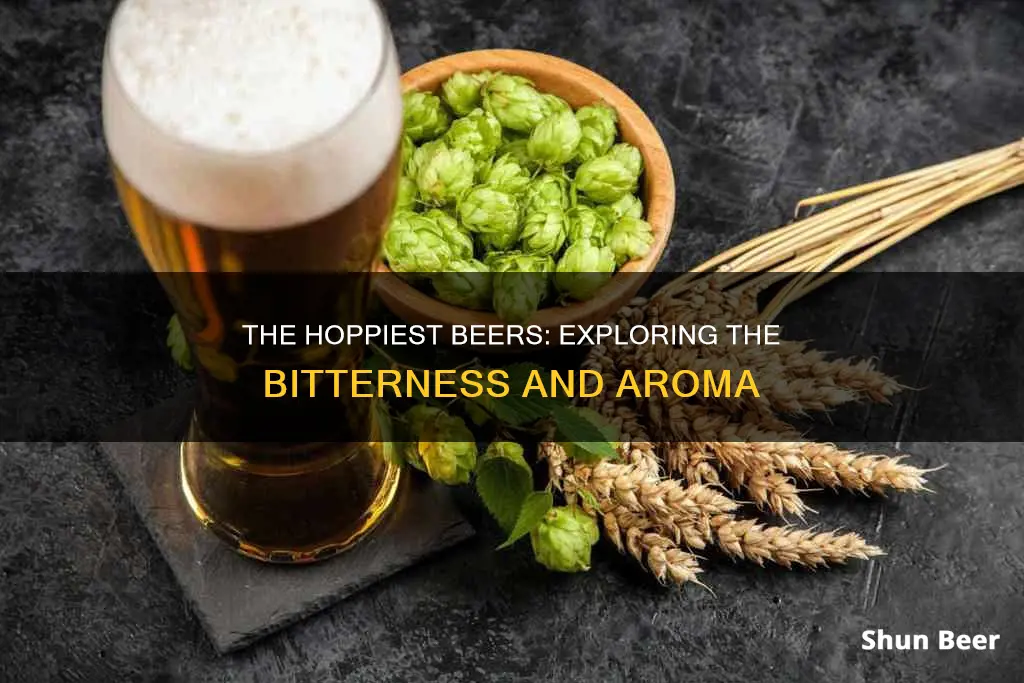
Hops are the hanging flowers of the Humulus lupulus plant, a climbing perennial. They are packed with oils and flavours and are considered one of the most important parts of any beer. They are added to beer to impart bitterness and aromatic flavours. While today, hops are an essential ingredient in beer, this has not always been the case. Before hops became standard, beers were balanced with other herbs and spices. Hops are now grown all over the world, but most American craft beer brewers source their hops from the Pacific Northwest.
Characteristics of beers containing hops
| Characteristics | Values |
|---|---|
| Appearance | Vibrantly green and cone-shaped |
| Plant type | Herbaceous climbing perennial |
| Latin name | Humulus lupulus |
| Native region | China |
| Grown region | Parts of Europe, New Zealand, the United States, Germany, the Czech Republic, Oregon, Washington |
| Flavours | Floral, minty, bitter, tropical fruit, citrus, stone fruit, piney, melon, apricot, etc. |
| Beer types | IPA, lager, stout, India Pale Ale, etc. |
What You'll Learn
- Hops are added to beer to impart bitterness and aroma
- The type of hops used can be bittering, aroma or dual-purpose
- Hops are added at different stages of the beer-making process depending on their function
- Hops have antimicrobial properties that help protect the beer from spoiling
- Hops are usually grown in the Pacific Northwest in the US

Hops are added to beer to impart bitterness and aroma
Hops are the cone-shaped flowers of the female hops plant, or Humulus lupulus. They contain alpha acids and oils that impart bitterness, flavour, and stability to beer. Hops are added to the boil stage of brewing to unleash their alpha acids, which takes around an hour. The longer the hops are boiled, the more bitter the flavour.
Hops are most famous for their bitterness, but they also add a variety of flavours, from floral to minty, and are responsible for the piney, citrusy, and floral notes in beer. They are added to beer to impart bitterness and aroma, and different varieties of hops will contribute different flavour notes and aromas. For example, Columbus hops add earthy and spicy notes, while Mosaic hops offer notes of berry and stone fruit.
The timing of when the hops are added also affects the flavour of the beer. When hops are added before the boil, their strong flavours and aromas are boiled into the brew, making the flavours stronger and more bitter. On the other hand, dry hopping involves adding the hops after the boil, resulting in less bitterness and more subtle, floral, and herbaceous notes.
The phrase "hoppy beer" can refer to the smell, flavour profile, or the volume of hops in a beer recipe. While bitterness is a key characteristic of hoppy beers, it is not the only factor that determines their flavour. The "hoppiness" of a beer can also be influenced by the type of hops used, the length of boiling, and the addition of other ingredients.
Hops in Near Beer: What's the Deal?
You may want to see also

The type of hops used can be bittering, aroma or dual-purpose
The type of hops used in beer can be categorised as bittering, aroma, or dual-purpose.
Bittering Hops
Bittering hops are added to the brew during the boil, which brings out the strong flavours and aromas of the hops. This makes the beer taste more bitter. The longer the hops are boiled, the more bitter the beer will be. Bittering hops are usually added at distinct stages depending on their function, be it flavouring, aroma, or bittering.
Aroma Hops
Aroma hops are added after the boil, which brings out more subtle, herbaceous notes. This process is called dry hopping. Aroma hops are used when the brewer wants to utilise the essential oils in the hops, which are far more volatile and can boil away.
Dual-Purpose Hops
Dual-purpose hops are used for both bittering and aroma. They have a high alpha acid content and excellent storage stability of alpha acids. They are often used in IPAs, Pales, and Bitters.
Exploring Mexican-Style Beer: A Hoppy Adventure
You may want to see also

Hops are added at different stages of the beer-making process depending on their function
Hops are added at different stages of the beer-making process, depending on their intended function. The function of hops in beer is fourfold: to contribute bitterness, add flavour, provide aroma, and help preserve the beer. The different functions of hops are achieved by adding them at different stages of the brewing process.
Hops are typically added to the wort in three stages: bittering, flavouring, and aroma. However, some beers may have only one addition, while others may have up to five or six. All beers, though, will have at least one addition of hops for bitterness to balance the sweetness of the malt. Without the bitterness from the hops, beer would taste overly sweet.
Bittering hops are added once the wort has been collected in the kettle and has started to boil. They are usually boiled for around 60 minutes but can be boiled for as little as 30 minutes. The longer the hops are boiled, the more alpha acids are released, increasing the bitterness.
Flavouring hops are added in the last 15 to 30 minutes of the boil. During this time, very little bitterness is extracted from the hops, but the crisp, hoppy flavour is imparted.
Aroma hops are added in the final 5 minutes of the boil or at flame-out, when the kettle is removed from the heat. This is because the hop oils responsible for the aroma are extremely volatile and will be driven off if boiled for too long. Adding aroma hops gives another dimension to the beer.
Techniques such as dry hopping and wet hopping are also used to add aroma without the extra bitterness. Dry hopping involves fermenting beer with hops, while wet hopping uses fresh, un-dried hops within 24 hours of being harvested.
Dry Hopping Beer: Pellet Power for Aromatic Brews
You may want to see also

Hops have antimicrobial properties that help protect the beer from spoiling
Hops have been used in beer production for centuries, primarily to achieve bitterness and aroma. However, hops also have antimicrobial properties that help protect the beer from spoiling.
Hops contain bitter acids, which are divided into alpha acids (humulones) and beta acids (lupulones). These bitter acids have been shown to have antimicrobial effects, particularly against gram-positive bacteria such as Lactobacillus, Streptococcus, Staphylococcus, Micrococcus, Bacillus, and Pediococcus. These bacteria can spoil beer, increase its turbidity, and produce unpleasant aromatic compounds.
The antimicrobial properties of hops are especially important in low-bitterness beers, such as wheat beers, low-alcohol, and alcohol-free beers, which are more sensitive to spoilage bacteria. By using late hop additions during the brewing process, brewers can increase the amount of alpha acids in the beer, enhancing its antimicrobial protection.
In addition to their antimicrobial effects, hops also contribute to the stability of the beer during shelf life. The hydrophobic nature of hop compounds allows them to penetrate the bacterial cell wall and damage the inner membrane, inhibiting the growth of bacteria.
Overall, the antimicrobial properties of hops play a crucial role in protecting beer from spoilage and maintaining its quality.
Hop Head Beers: A Guide to Bitter Brews
You may want to see also

Hops are usually grown in the Pacific Northwest in the US
Washington is the top hop producer in the US, followed by Oregon and Idaho. The Pacific Northwest has the ideal conditions for growing juicy, flavorful hops, with a milder climate and more predictable rainfall. The region's modern post-harvest storage and processing facilities ensure the highest crop quality is maintained, supplying the brewing industry with a wide range of products.
The history of hop production in the US began in the early colonial times, with the first commercial hop production established in 1648 in Massachusetts. By the mid-1800s, New York controlled the largest US hop acreage, but this later shifted to the Pacific coast states of Washington, Oregon, and California. Today, the Pacific Northwest, including Washington, Oregon, and Idaho, dominates US commercial hop production, with Washington's Yakima Valley being a prominent hop-growing region.
The hops grown in the Pacific Northwest are used in a variety of beers, including IPAs, lagers, and stouts. The region's hops are known for their intense flavours and aromas, contributing to the unique character of American craft beer. Brewers source hops from this region to create distinctive and consistent flavours in their beers.
The Art of Describing Beer Hops
You may want to see also
Frequently asked questions
Hops are the hanging flowers of the Humulus lupulus plant, a climbing perennial. They are cone-shaped and green in colour.
Hops are famous for their bitterness, but they also provide a variety of flavours, from floral to minty. Hoppy beers can also have notes of tropical fruit, citrus, stone fruit, pine, spice, melon, and apricot.
A hoppy beer can refer to the smell, flavour profile, or volume of hops in a beer's recipe. When we talk about hoppiness, it is a mistake to think only of bitterness. A beer's bitterness is often measured in IBUs (International Bitterness Units).
Beers with high IBUs include Triggerfish the Kraken, Hart & Thistle Hop Mess Monster, Dogfish Head Hoo Lawd, and Arbor Steel City DCLXVI. Popular hoppy beers include Ninkasi Brewing Total Domination, The Alchemist Heady Topper, Beer Valley Leafer Madness, and Avery Brewing India Pale Ale.







